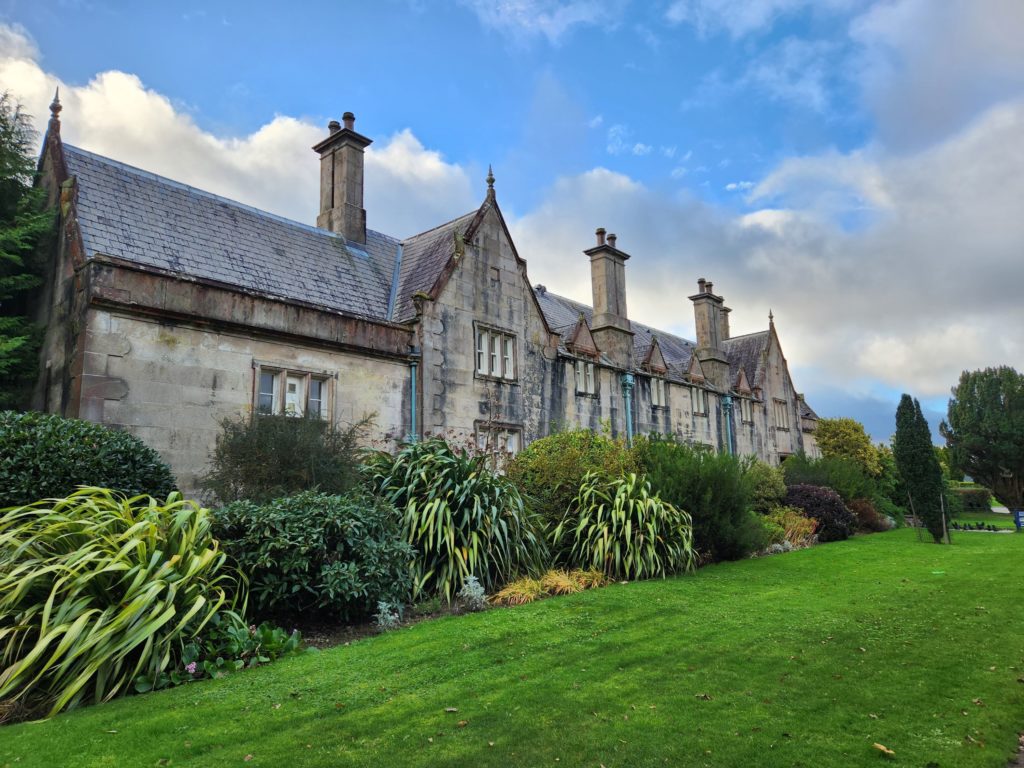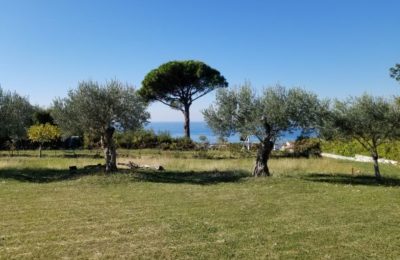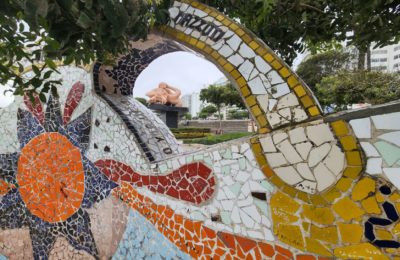Driving the Ring of Kerry was one of the highlights of my Irish road trip. I didn’t expect to enjoy it nearly as much as I did. It was a treat to be overloaded with Ireland’s natural beauty, ancient architecture, history, Celtic folklore and culture all in one day.
However, resources for where to stop along the 111-mile (179-kilometer) loop brimming with natural, cultural and historical sites were hard to find.
The night before driving the Ring of Kerry, I stopped in a pub and asked a local if he had any recommendations for where to stop. I couldn’t find a good account on the internet that outlined which stops were most worthwhile, so I thought asking a local might be best.
His advice? Follow your eyes.
Maybe if you live in County Kerry and don’t have a limited amount of time this could be sound advice. However, if you’re someone traveling from another continent and are on limited time, this is probably not the advice you want.
When researching where to stop when driving the Ring of Kerry, I found it difficult to find complete guides to stops and lookout points. I wanted to put together a more comprehensive list of recommended stops, with explanations as to why I recommend them.
Following your eyes is still a good practice for driving the Ring of Kerry. You’ll want the freedom to pull over when you see exceptionally beautiful vistas. However, it’s still a good idea to have some key points on the map pinned where you want to pull over.
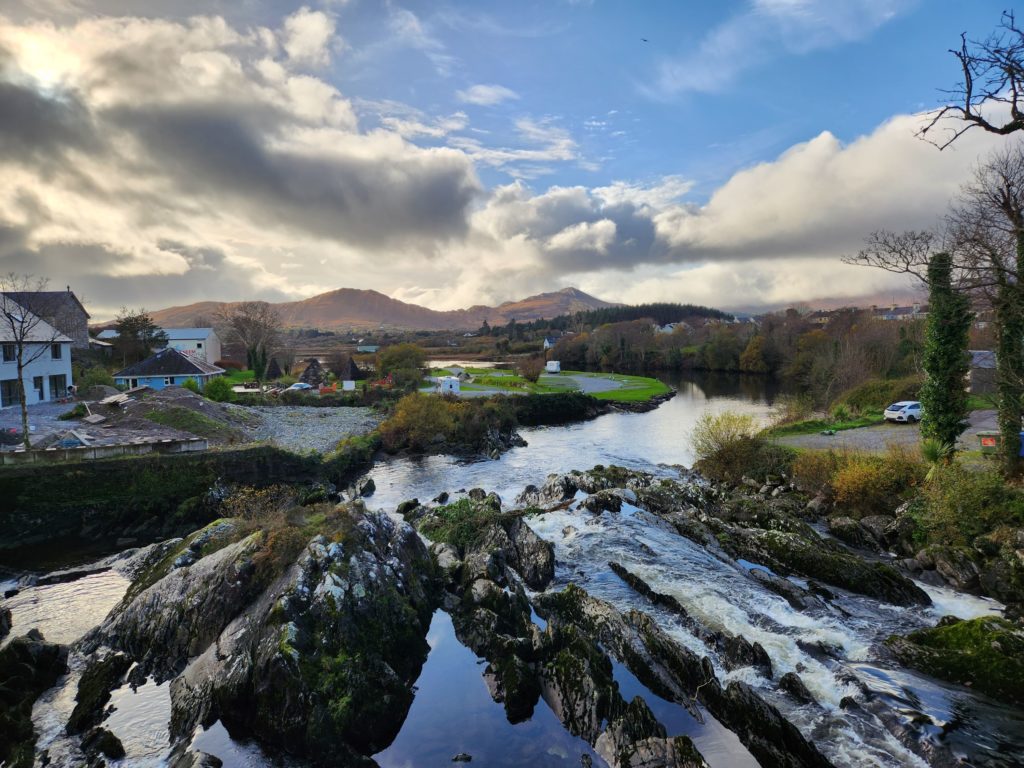
Here are the places I pinned:
I’ve elaborated more on each of these places in the the body of the post, but here is the TL;DR:
- Ross Castle (recommend)
- Muckross House & Gardens
- Muckross Abbey (highly recommend)
- Torc Waterfall (recommend)
- Muckross Lake Viewpoint (recommend)
- Killarney National Park (recommend)
- Ladies View (highly recommend)
- Moll’s Gap
- Town of Kenmare (recommend for the Stone Circle & Fairy Trees)
- Town of Sneem (highly recommend – do the sculpture walk)
- Staigue Stone Fort
- Waterville Heritage Trail
- Skellig Island Viewpoints (highly recommend)
- Kerry Cliffs (highly recommend)
- Kells Bay House & Gardens (ran out of daylight and didn’t make it)
- Gap of Dunloe (ran out of daylight and didn’t make it)
Quick tips for driving the Ring of Kerry:
If you’re driving the Ring of Kerry, here are a few tips to keep in mind.
- Start in Killarney and drive clockwise. Especially if you’re visiting during peak or shoulder season, you want to drive clockwise to avoid being stuck behind tour buses that go counter-clockwise.
- Bring plenty of €1-€2 coins. A lot of the smaller attractions have cheap entry fees based on the honor system. You’ll need some coins to drop in the deposit box.
- Pack some snacks. Though you can stop in one of the villages for lunch, you might not have time if you’re racing against the daylight like we were. Besides, the Ring of Kerry is basically a road trip, and every good road trip requires snacks.
- Try to allocate more than one day, if you have the time. My biggest regret was that I only allocated one day to the Ring of Kerry and ran out of daylight to see everything I wanted. I especially recommend allocating at least two days if you’re visiting in the winter when days are shorter.
More logistics can be found at the bottom of this post. But first, here is everywhere you should stop while driving the Ring of Kerry.
Ross Castle
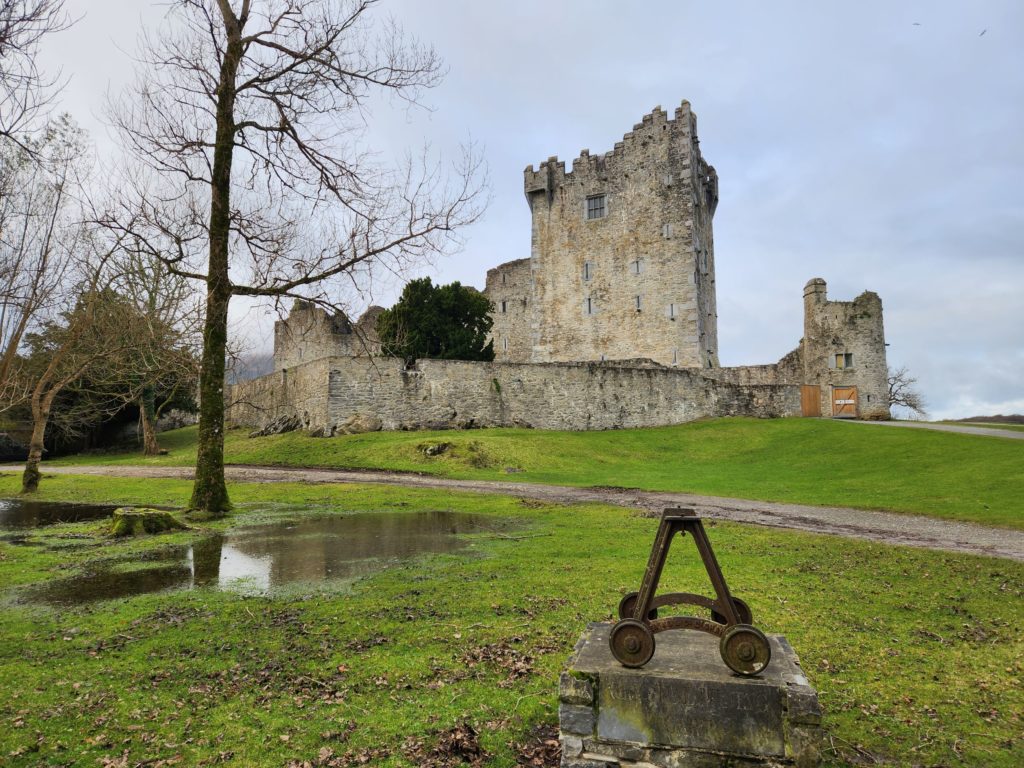
Ross Castle is a sturdy 15th-century castle standing in Killarney National Park. If you’re staying in Killarney and driving clockwise, it’s a popular first stop on the loop. It was originally built for the area’s ruling clan, O’Donoghues Mór (Ross), but changed ownership several times throughout history. Before it became a public tourist attraction, it was most recently a military barracks.
During Ireland’s main tourist season, you can tour the inside of the castle and possibly take a guided tour. Because we visited in November, the inside was not open, but we enjoyed seeing it from the outside and walking around the perimeter.
If Ross Castle is your first stop on the Ring of Kerry, and you want to go inside, know that the earliest it opens is 9:30.
Muckross House & Gardens + Traditional Farms
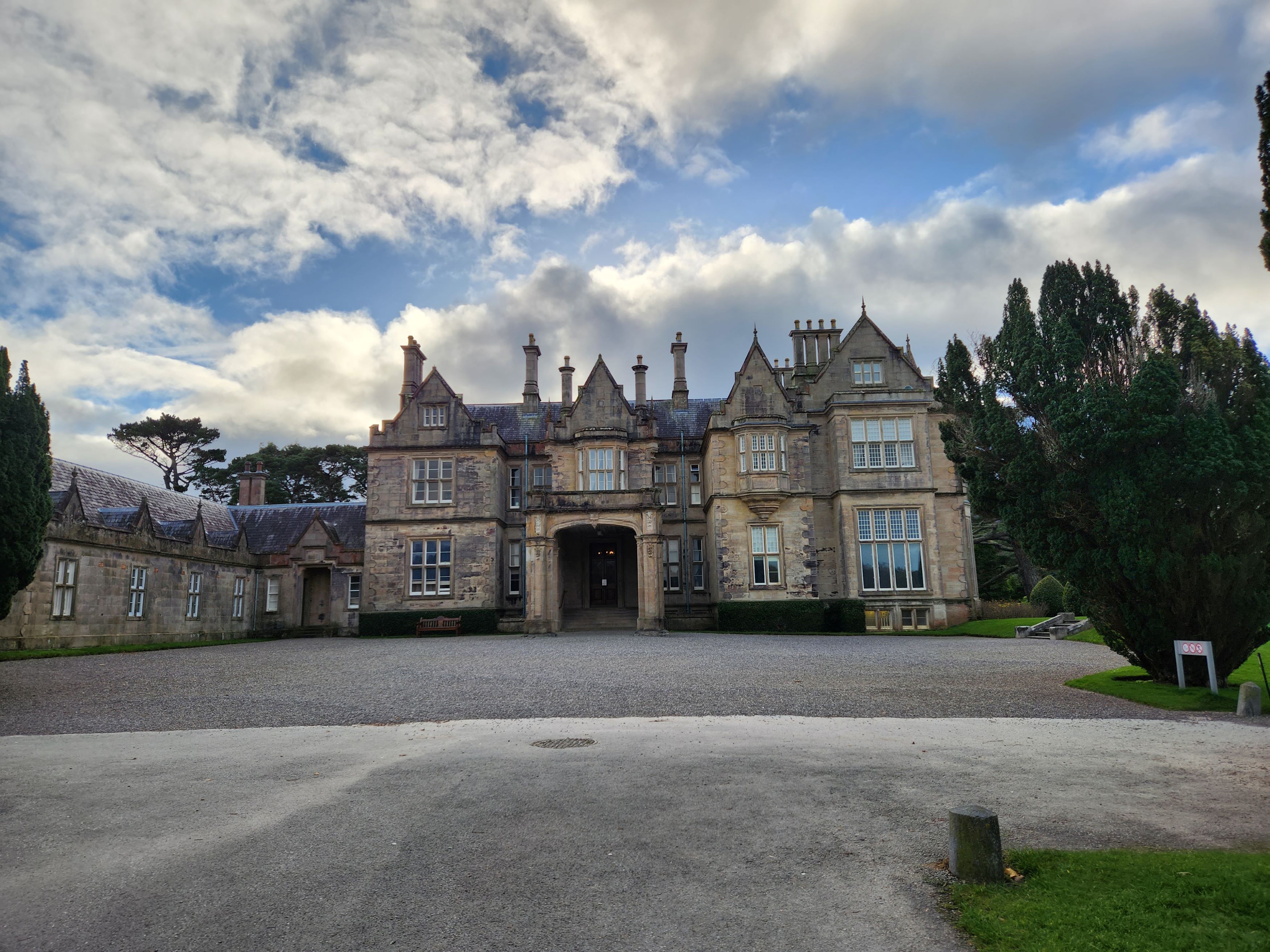
The Muckross House is a 19th century Victorian mansion situated on the edge of Muckross Lake in Killarney National Park. It was owned by a prominent political family in County Kerry and is an impressive structure. This estate also has gardens renovated for Queen Victoria’s visit.
It costs €7 to tour the inside of the house, and an extra €7 to visit the on-site Traditional Farms for adults. We opted to just admire the mansion and landscaping from the outside to save on both money and time.
Muckross Abbey
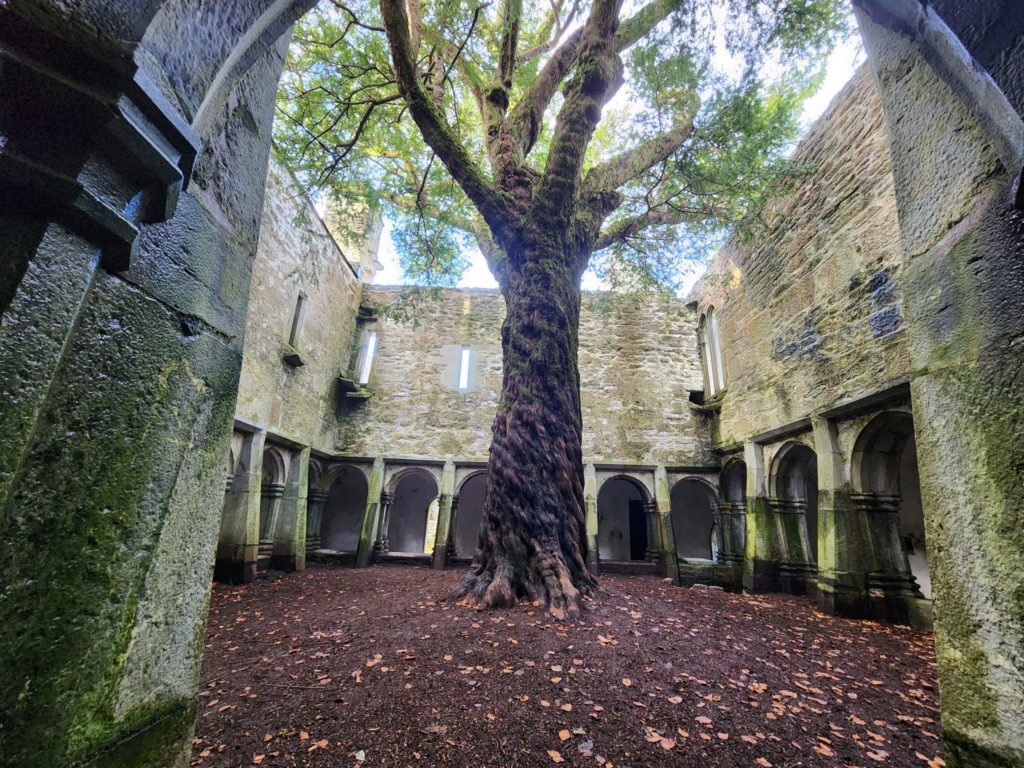
Muckross Abbey is a 15th century Franciscan friary and was one of my favorite stops on the Ring of Kerry. It’s an easy 20-minute walk from the Muckross House through Killarney National Park to reach it. Initially, we weren’t sure if we wanted to go a bit out of our way to see it. But as we approached the historic stone building surrounded by an ivy-covered cemetery, we knew it was the right decision.
The friary is mostly still intact. You can explore the areas like the original kitchen and monks’ bedrooms and admire the bones of the old building. You can also climb to the top of the Abbey via a winding narrow staircase and get a lovely view of Killarney National Park.
My favorite part of Muckross Abbey was the venerable yew tree in the center of the courtyard. This yew tree is thought to be at least as old as the Abbey, and potentially the oldest yew tree in Ireland. Some theories say the Abbey was built around the tree. Since the pre-Christian druid era, yew trees were a symbol of everlasting life and rebirth. In some cases, the yew was adopted in Christianity as a symbol of death and resurrection.
Regardless of what it stands for, the yew tree at Muckross Abbey stands firmly in the center of the courtyard. It is unyielding and commands attention from anyone exploring the interior of the Abbey. No matter what you believe, this yew tree reminds you of the force of life and how nature finds a way to thrive.
Torc Waterfall
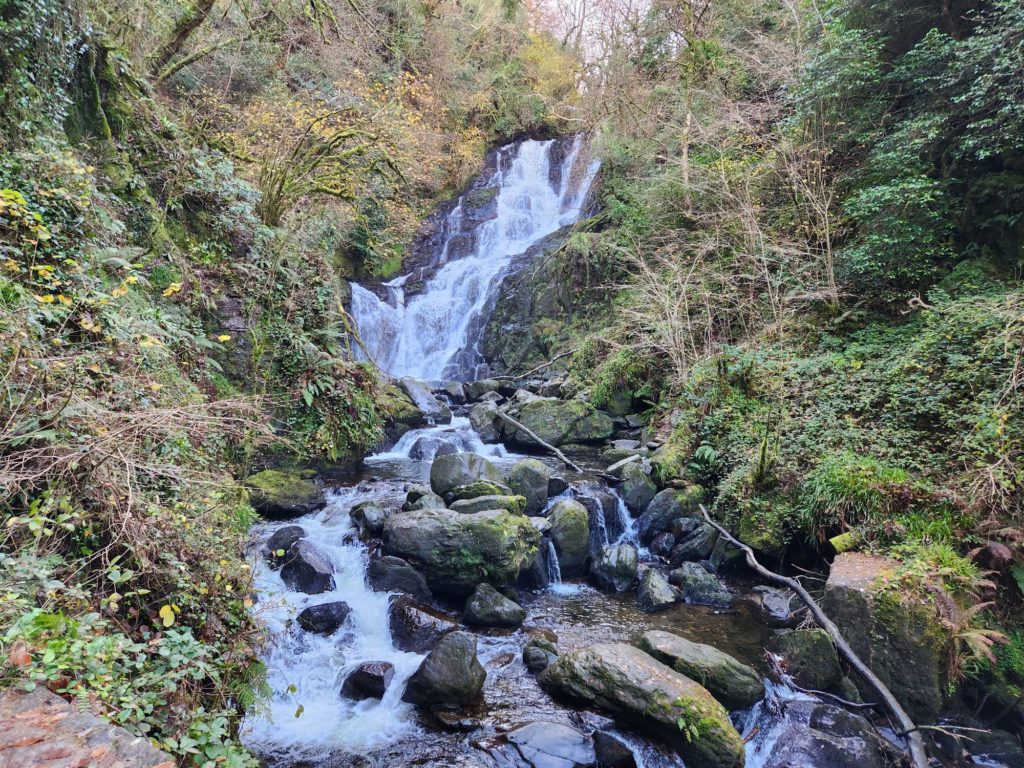
Torc Waterfall sits at the base of Torc Mountain in Killarney National Park. The waterfall is more than 65 feet/20 meters tall and cascades over boulders and trees, flowing from the Owengariff River.
We faced a bit of confusion visiting this waterfall, and I don’t think we were the only ones. When we were researching getting to the waterfall, we read it was a bit of a hike to see the main part of the waterfall after parking. However, if you’re following the Ring of Kerry clockwise and park just off the Ring of Kerry road in a small lot, the waterfall is only a few minutes’ walk with no real elevation gain.
That was exactly what we did. So after walking for about 2 minutes to the base of the gushing waterfall, we assumed there was more to see. We took a few moments to admire the falls from their viewing platform, which also has dozens of stone steps ascending the mountain attached to it. Thinking that there must be more to the falls based on what we’d read, we decided to climb the 100+ steps up the mountain to get to the “main” viewpoint.
It wasn’t until we met a group of fellow tourists at the top that we learned we’d already seen the main viewpoint. We also learned there’s another parking lot near the top of the falls, which is why we were all confused. It’s better to park at the bottom off the Ring of Kerry road if you prefer to not have to walk down then up the stone steps.
We didn’t really mind getting the bit of extra hiking in, but we only had so much daylight to waste.
Muckross Lake Viewpoint
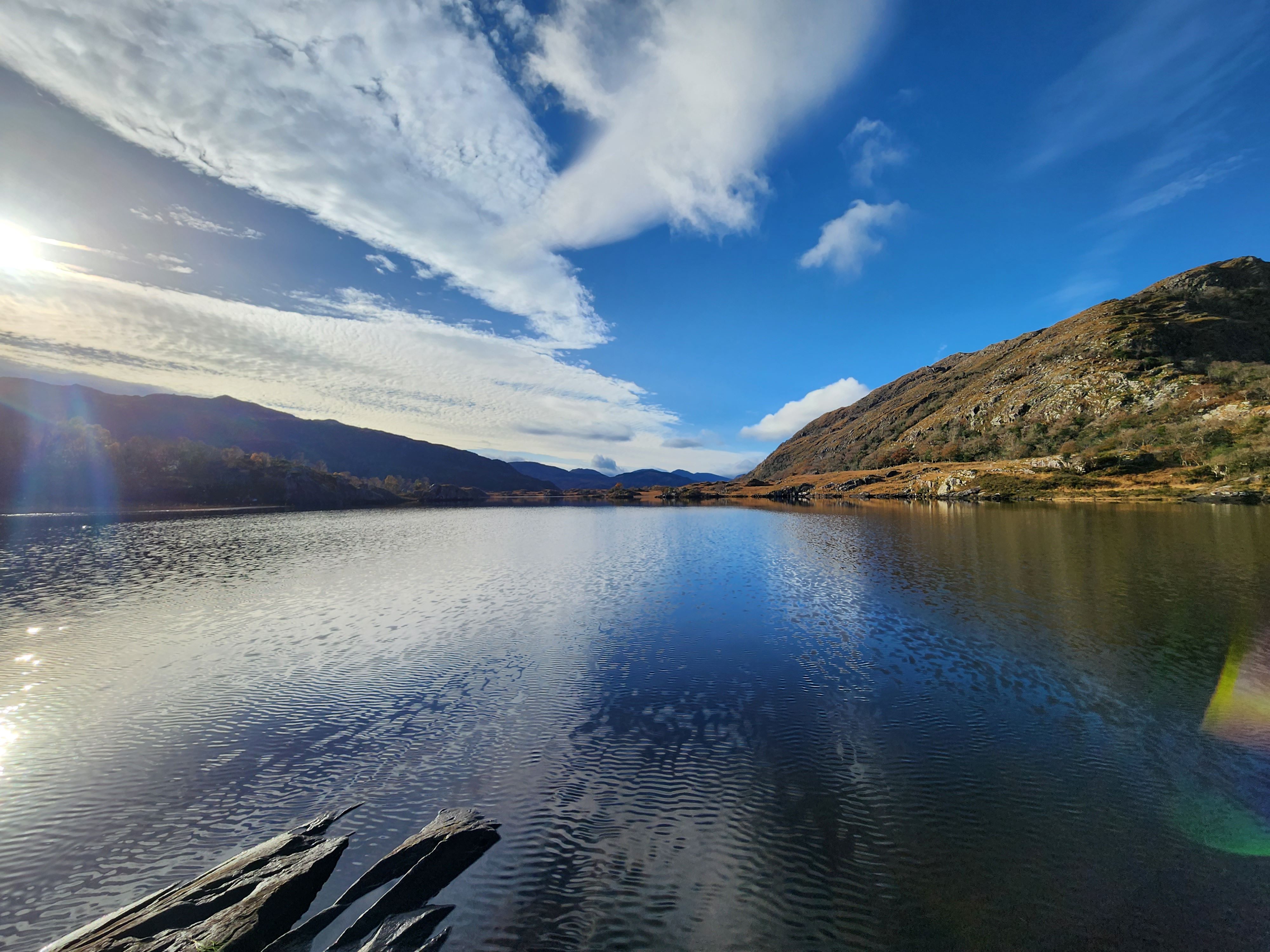
Though we planned out a lot of our stops along the Ring of Kerry, we did do a good bit of “following our eyes.” The first time was along the shores of Muckross Lake.
A sign warned us that we were approaching a scenic viewpoint. We pulled over to find we were looking out over a gorgeous mirrored lake. There was a rock extending from the shore into a good portion of the lake. I carefully walked out to the farthest point of the rock and admired the reflection of the mountains and trees in the lake.
I recommend pulling off and taking a few moments to admire this lake.
Killarney National Park
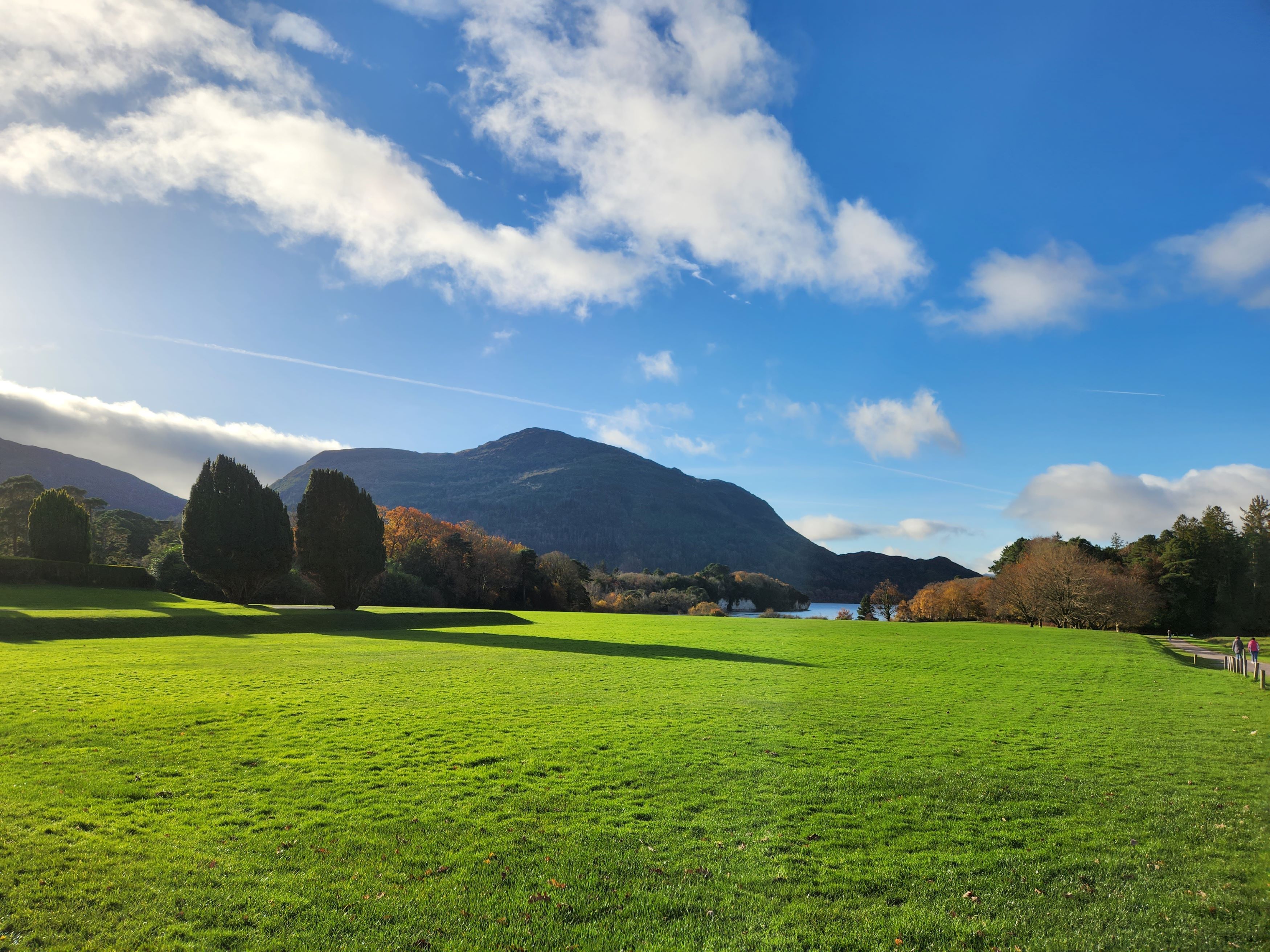
If you’ve stopped at any of the first five stops mentioned in this post, you’ve already seen a good portion of Killarney National Park. Still, I wanted to note the park as a stop to point out that you don’t have to choose between driving the Ring of Kerry and spending time in the national park.
See, when I was doing my research on the Ring of Kerry, I didn’t realize how much of the park I’d have a chance. Killarney National Park is 3,000 acres of nature trails and historic structures and frequently listed as one of the best places to listed in County Kerry. You’re not going to see the entire park if driving the Ring of Kerry, but you’ll get a good taste of it with these early stops.
Ladies View
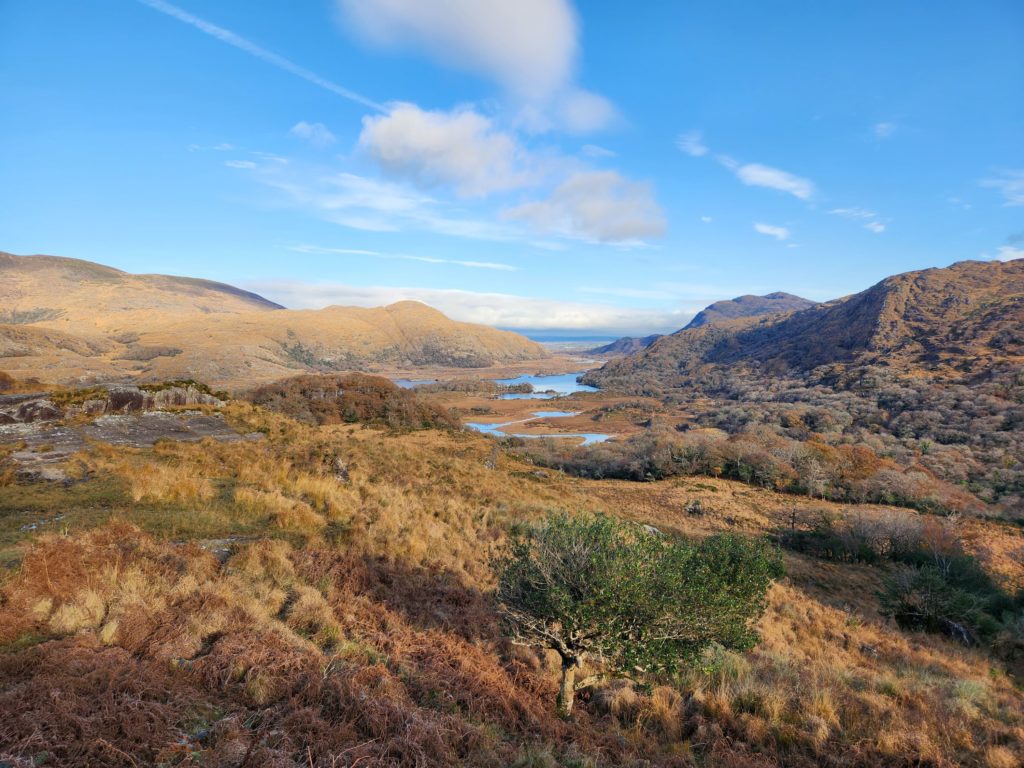
Ladies View is one of the most popular scenic lookouts along the Ring of Kerry. It’s called “Ladies View” because Queen Victoria’s ladies-in-waiting would frequently admire the view.
The view is hard to perfectly capture in a single photograph. Looking out over Killarney National Park, the image of the Killarney lake snaking through the valley and into the mountains will take your breath away.
You can spend as long or as little time as you want at Ladies View, but I definitely recommend stopping at the viewpoint for at least a few minutes.
Moll’s Gap
Moll’s Gap is often listed as a place to stop along the Ring of Kerry, but it’s really more of a scenic view to enjoy during the drive. The gap is an example of a glacial breach and offers a view of MacGillycuddy’s Reeks Mountains.
Honestly, Moll’s Gap was a little bit of a disappointment after Ladies View. But because it’s right on the route, it’s worth seeing.
Kenmare (Stone Circle & Fairy Trees)
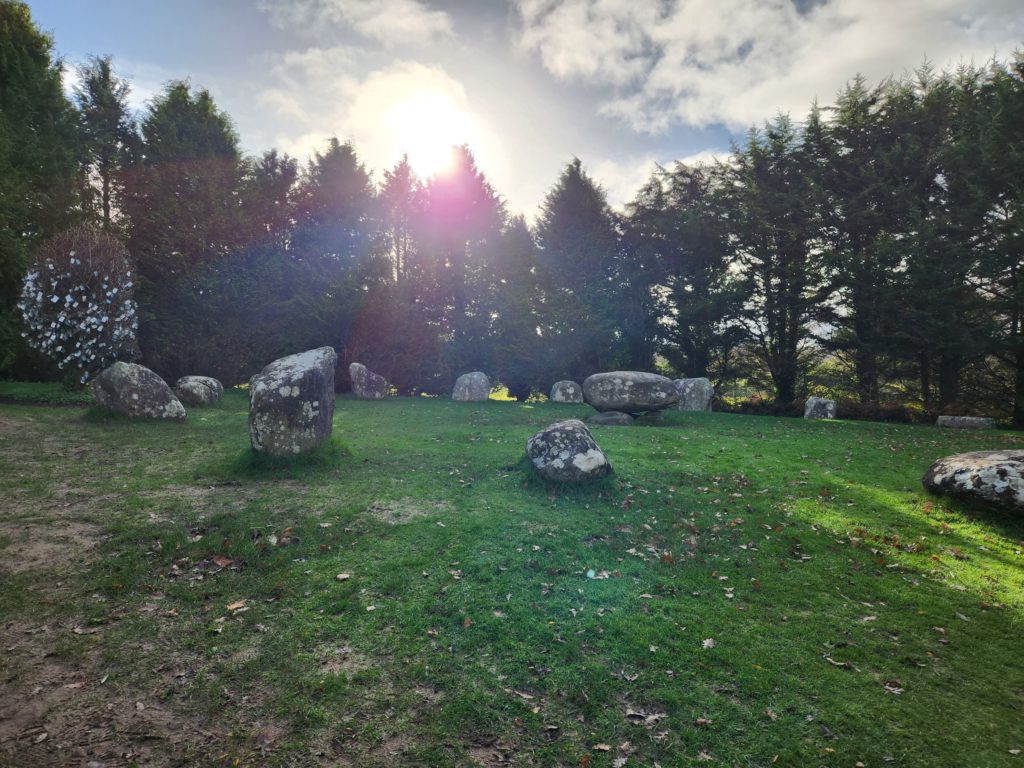
Kenmare is a small town situated along the Ring of Kerry. If you have multiple days to drive the ring, or if you want to make your home base somewhere other than Killarney, Kenmare is a good option. Rick Steves claims he likes staying in this town better than Killarney as he finds it less touristy. I personally disagree as I enjoyed Killarney and found Kenmare pretty touristy. So, you’ll have to choose who to trust.
Whether you want to stay in Kenmare or not, it’s worth stopping in the town during your Ring of Kerry drive. The town of Kenmare has a lot of charm, with colorful houses lining the street.
The real reason to stop in Kenmare, though, is the Stone Circle and Fairy Trees. Stone Circles are circles comprised of large boulders and were created throughout this region from about 2,200 to 500 BC. Historians believe they were erected for ritual purposes. The Kenmare Stone Circle is well-preserved and one of the largest in Southwest Ireland.
Next to the Stone Circle, you’ll also see Hawthorn Fairy Trees. Hawthorn trees are considered sacred in Ireland – so much so that building plans have been disrupted due to Hawthorn trees being discovered. The Hawthorn Trees in Kenmare are covered in wishes left by visitors. You can write a wish on a piece of paper and leave it on the tree to come true.
Sneem (Sculpture Trail)
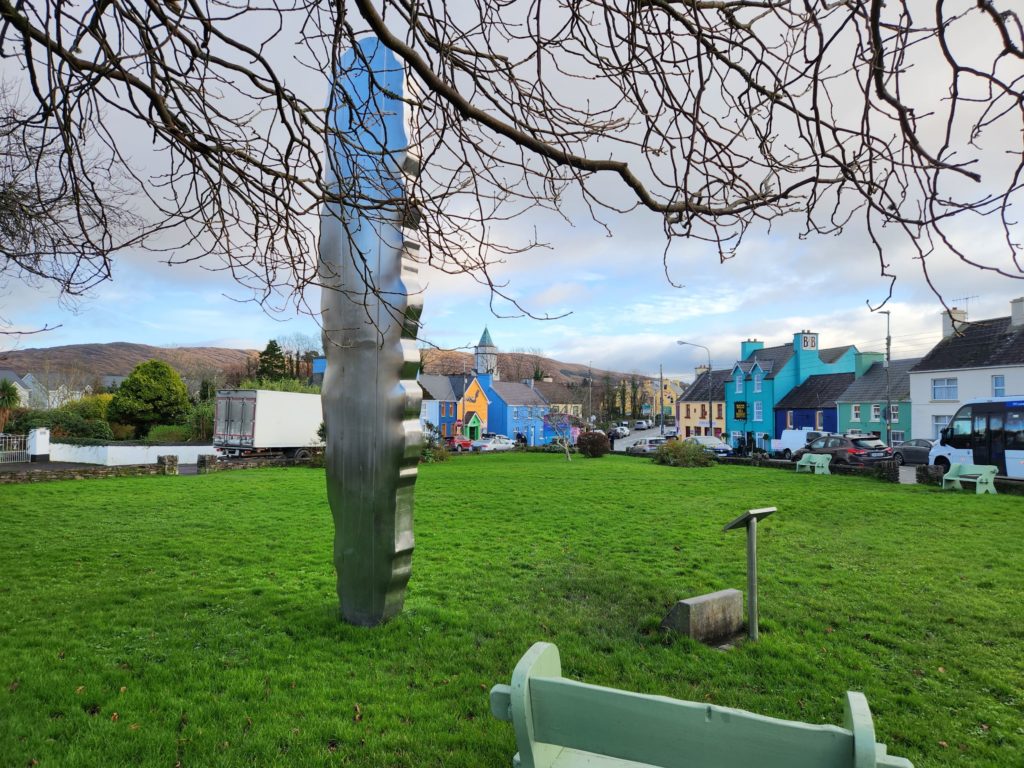
Sneem is another small town along the Ring of Kerry. I personally thought it seemed more interesting and authentic than Kenmare and would have gladly stayed a night there if I had more time.
If you’re popping into town as a stop along the Ring of Kerry drive, I highly recommend walking the Sneem Sculpture Trail. It is a collection of about 14 sculptures and monuments located throughout the town. Many of these sculptures signify Ireland’s relationships with other nations around the world.
The Sculpture Trail is very accessible, as there are plenty of maps and signs throughout the town showing where to go. It is a great way to get to see the small town of Sneem, enjoy some art and learn a bit about the country’s international relations.
Staigue Stone Fort

Staigue Fort is a traditional ring fort situated a few miles inland atop a hill overlooking the surrounding areas. From the fort, you can still see all the way out to the coast and into the ocean.
The fort dates back to pre-Christianity Ireland, though its exact date of construction is unknown. It was constructed with rocks that interlock, with no sort of binding material to hold them together. When you get up close to the fort, you can see exactly the care taken in constructing the fort and marvel at the fact that it’s still standing centuries later.
The fort is a little more out of the way than other stops on the peninsula, as you have to drive slowly down a dirt road off the main road to get to it. I added it to our itinerary because we both wanted to see a fort during our Ring of Kerry drive. But if you’re short on time, I might recommend skipping.
Waterville Heritage Trail
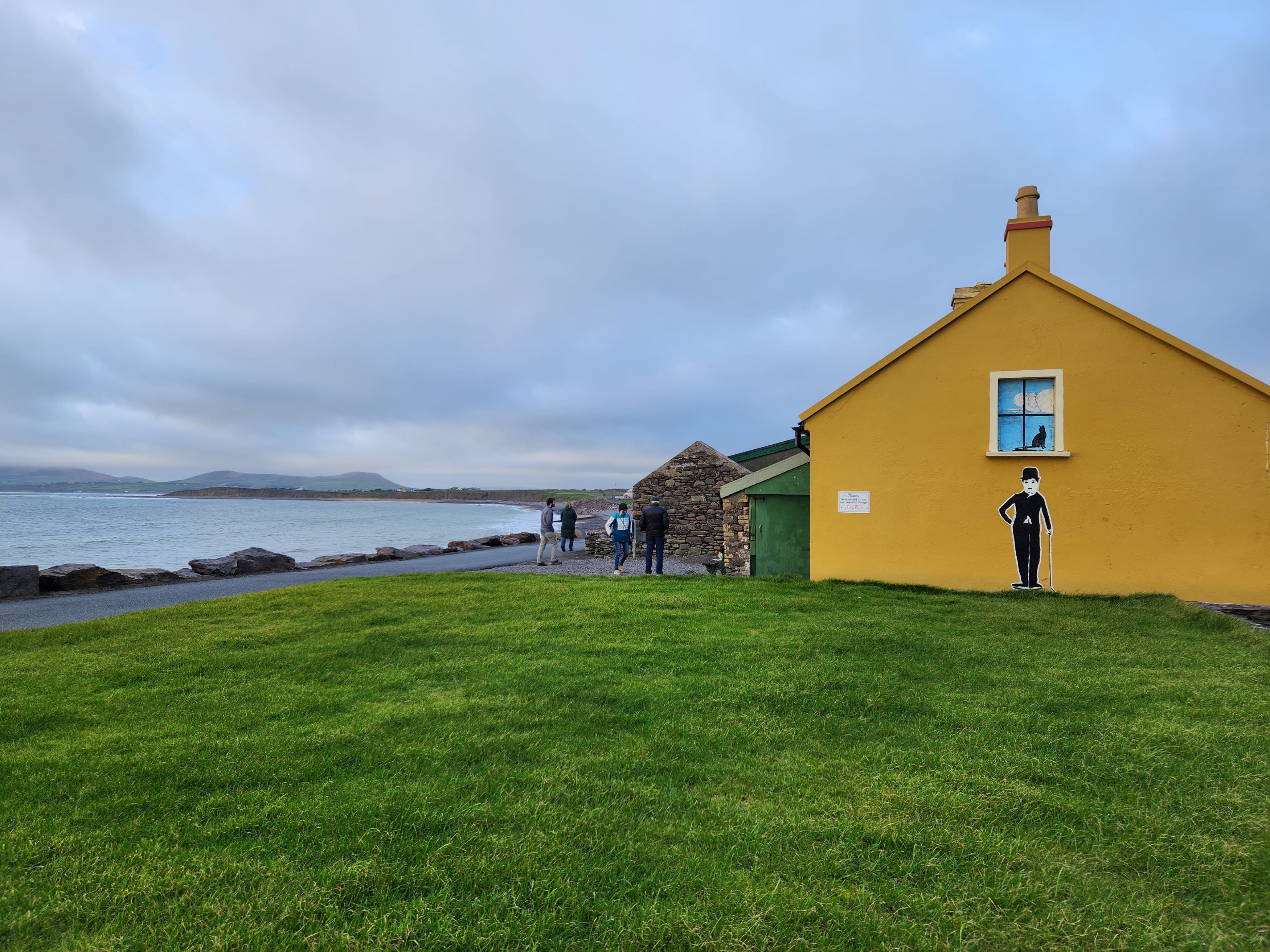
Waterville is a town on the end of the peninsula, about halfway through the traditional Ring of Kerry drive. It’s popular to stop in Waterville for lunch before finishing the drive, or to stay here overnight as a halfway point.
One of the main things to see in Waterville is the Heritage Trail, which is a walking trail that starts along the beach and goes through the town to teach you Waterville history. Because we were running out of daylight, we only walked a small portion of the trail that went along the beach. But we did get to admire the Charlie Chaplin statue and learn about how much he and his family loved Waterville.
Viewpoints of Skellig Islands
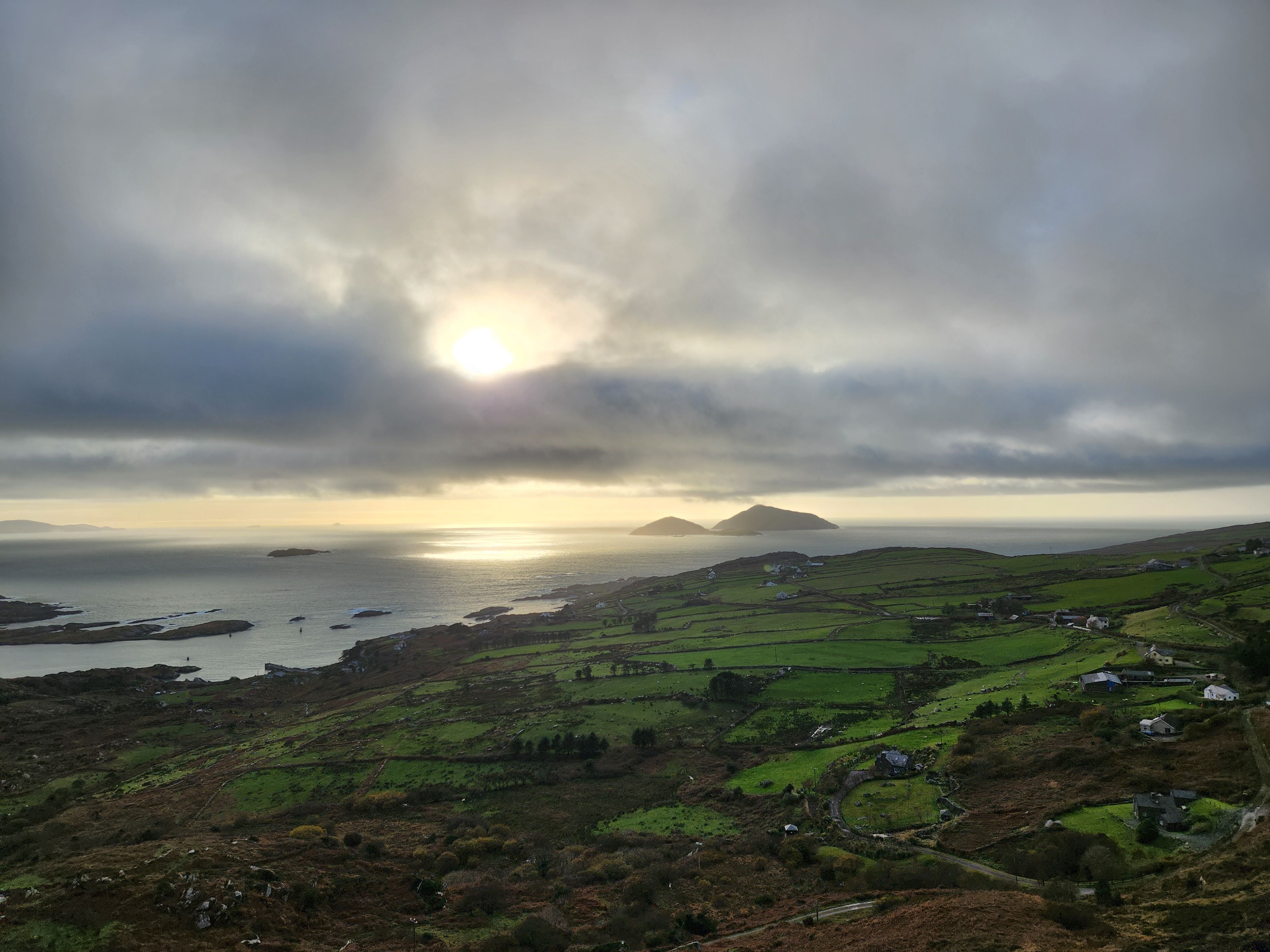
Leaving Waterville is when I really started to understand the “follow your eyes” advice the Killarney local had given me. The drive at this point was along the Wild Atlantic Way and had some of the best scenery of the entire drive.
One of the highlights of this drive was the view of the Skellig Islands. The Skellig Islands are UNESCO World Heritage Sites and popular as filming locations for movies like Star Wars. If you have extra days, you can take a boat tour of the islands. But if not, you’ll have to be satisfied with seeing them from lookout points along the Ring of Kerry.
There are plenty of viewpoints where you can pull over and admire the views along the peninsula. The view was so incredible that we stopped at multiple points to enjoy it.
Kerry Cliffs
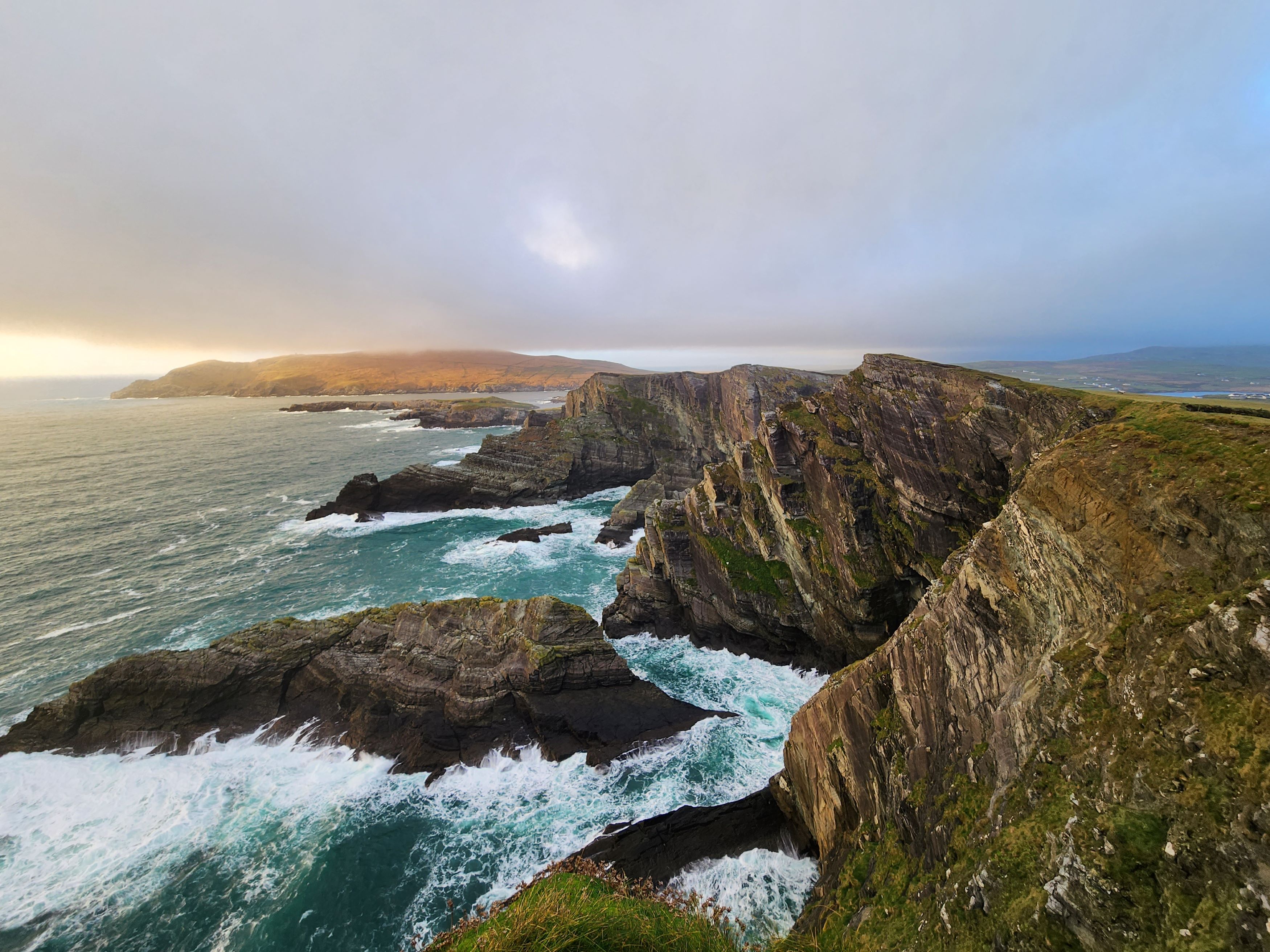
After Waterville, you can choose to finish out the traditional Ring of Kerry drive, or tack on a little more driving to include the Ring of Skellig. We chose to do the latter in order to see the Kerry Cliffs, and we were not disappointed.
The Kerry Cliffs are dramatic sea cliffs located at the tip of the Skellig Peninsula. Though we had already seen the Slieve League Cliffs and Cliffs of Moher during our road trip, the Kerry Cliffs did not fail to impress us.
People tend to compare the Slieve League Cliffs to the Cliffs of Moher when deciding what sea cliffs to visit in Ireland. However, I think the Kerry Cliffs are a much more apt comparison to the Cliffs of Moher. If you’re looking for an alternative to accessible views of jagged sea cliffs against the wild Atlantic Ocean, I recommend Kerry Cliffs.
Kells Bay House and Gardens
We left Kerry Cliffs as the sun was setting, so didn’t quite get to finish out the planned stops on the second half of Ring of Kerry. This is a potential downfall of visiting in the winter when the days are shorter, or only allocating one day to driving the Ring of Kerry. Luckily, most of what we wanted to see was on the first half of the peninsula, so we did not feel like we were missing out too much.
However, one of the stops in the second half I was interested in seeing was Kells Bay House and Gardens. The Kells Bay Gardens are 20 hectares (49 acres) worth of domestic and foreign plants, kept alive in a unique microclimate right along the Ring of Kerry. Exploring the gardens is supposed to be an immersive experience that takes visitors on paths across rope bridges to discover the unique topography and diverse plants. Unfortunately, the gardens are only open during daylight hours, so we missed out on seeing them.
Gap of Dunloe
The other stop we missed out on due to time and daylight constraints was the Gap of Dunloe. Gap of Dunloe is another scenic drive and viewpoint along the Ring of Kerry. It is another example of a glacial breach along the peninsula. The view shows the gap between the Reeks Mountains and the Purple Mountain range.
I was sad to miss out on seeing the Gap of Dunloe, but was definitely satisfied with all the natural beauty I’d seen throughout the Ring of Kerry.
Have I convinced you to drive the Ring of Kerry yet? If so, here are some key logistics.
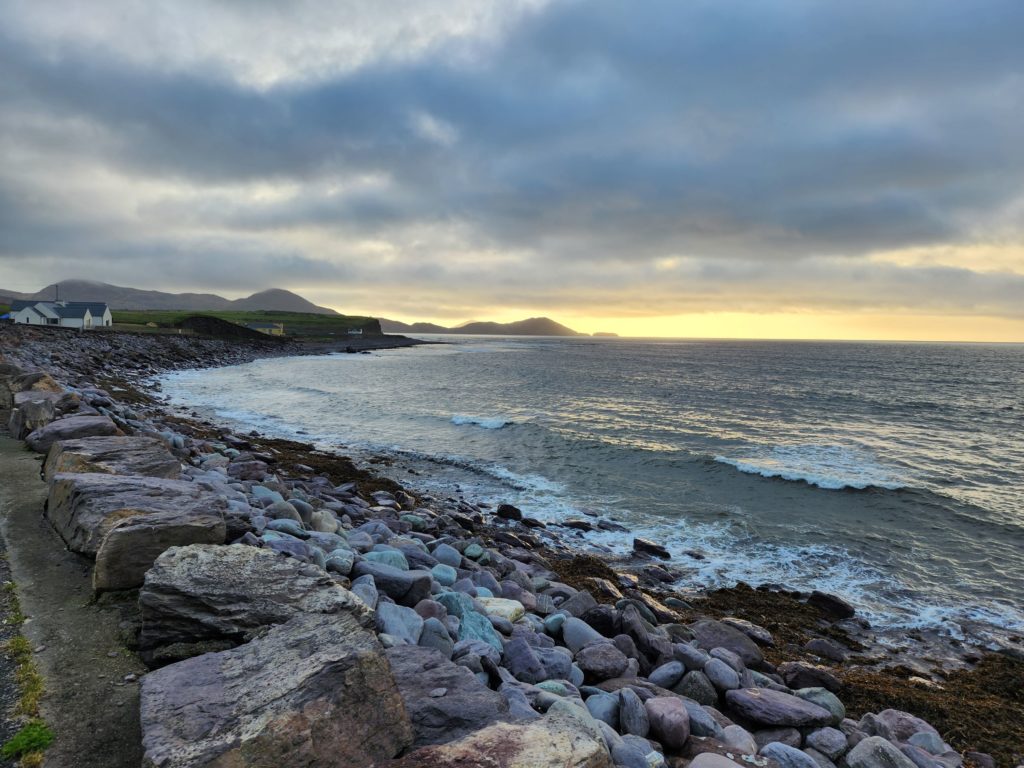
Where to Stay:
The Ring of Kerry technically “starts” in Killarney. But really, you can start anywhere you choose along this road in County Kerry. We started in Killarney and enjoyed our time in the town despite it being a bit touristy.
Other popular places to stay include Kenmare, Sneem and Watertown.
Transportation for driving the Ring of Kerry:
There are two main ways to traverse the Ring of Kerry: Car or bus tour.
The advantages of the tour bus are that you don’t have to worry about renting a car and driving in Ireland, which can be an especially big pro if you’re not used to driving on the left side of the road. You can also only choose this option if you’re traveling during Ireland’s primary tourist season (May-September).
The disadvantage is that you have to follow only the stops on the tour bus. You’ll also likely be with other crowds of tourists as tour buses tend to follow the same route.
If you choose to drive, the main pro is the flexibility. You can choose to drive whatever direction you want and stop wherever you want along the route. A self-drive tour is especially popular if you’re planning on taking multiple nights to complete the Ring of Kerry.
If you choose to self-drive the Ring of Kerry, I recommend driving clockwise from Killarney. The tour buses drive counter-clockwise, which means you’re highly likely to get stuck behind large buses driving in the same directions.
There are also some private tours that leave from Killarney if you prefer to hire a private driver for ultimate relaxation and flexibility, and if you don’t mind paying a bit more.
Time of Year for Driving the Ring of Kerry:
The most popular time to drive the Ring of Kerry is June to August, with shoulder season in May and September. These months give you the best chance to have good weather, though it is never a guarantee. In fact, July 2023, one of the most popular months to visit Ireland, saw daily rain. However, if you’re hoping to join a tour bus, you’ll have to choose one of these months.
We traveled in November and had exceptionally beautiful weather. It was a little chilly (~50 F), but also happened to be very crisp and sunny. In fact, this was the sunniest day we saw on our trip. One of the biggest benefits of traveling during the off-season is that you’ll have far fewer people on the tour than you would otherwise.
This can be a major blessing if you’re self-driving as there’s no chance to be stuck behind tour buses. There are also far fewer chances to be stuck behind unconfident drivers doing half the speed limit on the road. However, there is a higher chance for roadwork during the off-season.
The biggest con of driving the Ring of Kerry in the off season is that the days are shorter during the winter. Shorter days mean you have a shorter time frame to see all the natural beauty along the Ring of Kerry. You have to fit more into one day, or spread this trip across multiple days.
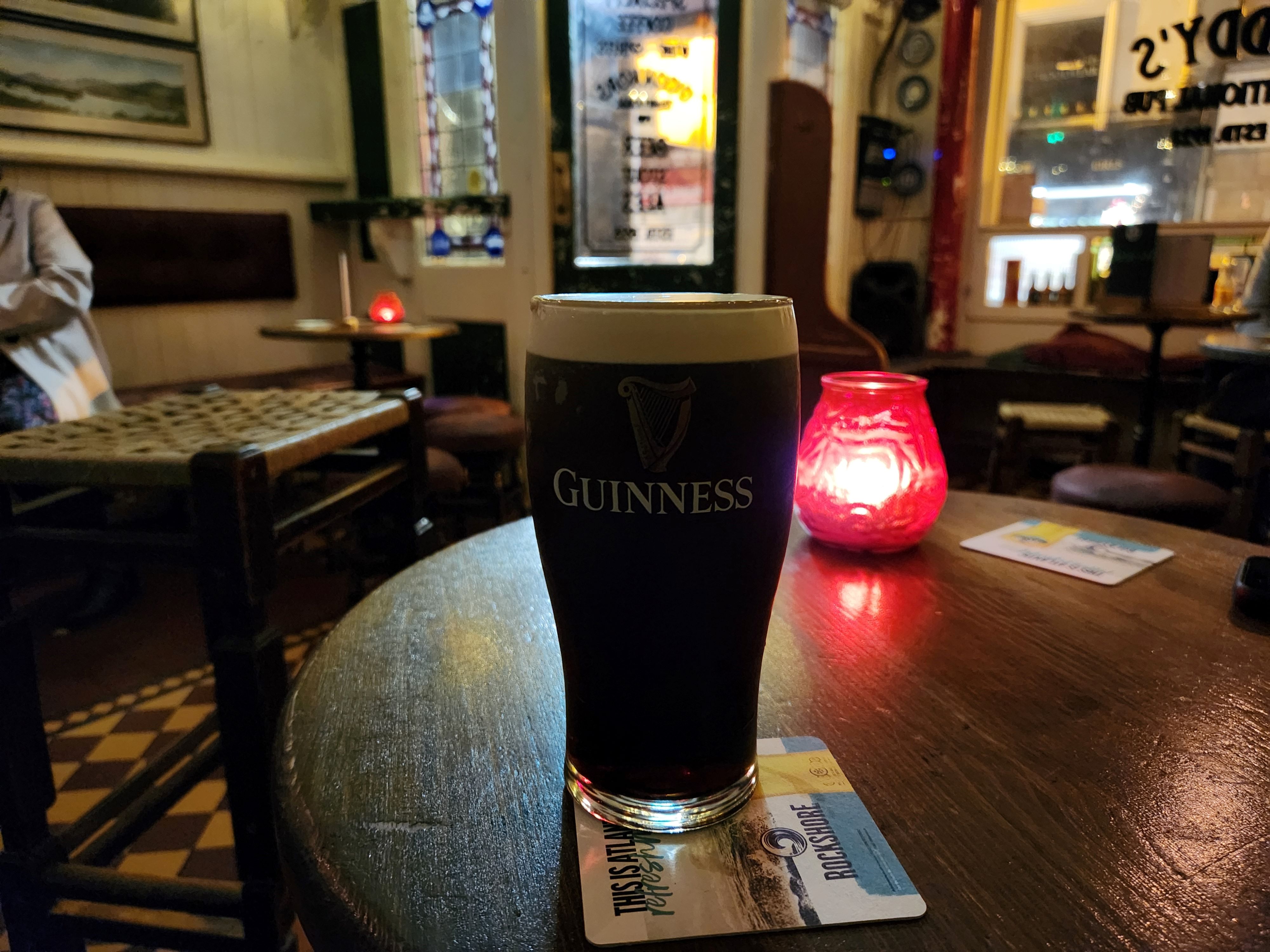
Number of Days:
We drove the Ring of Kerry in one day, in November when the days are shorter. I would only recommend trying to fit the Ring of Kerry into one day if you’re limited on time like we were.
You can certainly see plenty of interesting sites along the ring of Kerry within about eight hours. However, you have to be aware of time throughout your entire drive. Even then, we ran out of time to see absolutely everything we wanted and had to make tradeoffs. In fact, we didn’t really get to see the last third of the Ring of Kerry because we only had one day to devote to it.
If you can afford to spend 2-3 days driving the Ring of Kerry, I recommend doing so. With more time, you can spend longer at intriguing stops and in some of the small towns. You can also add the Ring of Skellig and/or the Dingle Peninsula to your trip.
My perfect Ring of Kerry tour would have included a night in Killarney for the first half of the ring. Then, I’d stop at the end of the ring in Watertown for a night before ending the trip back in Killarney.
After all, Killarney did have one of my favorite pubs from our Irish road trip.
There seemed to be endless places to stop while driving the Ring of Kerry. If you simply “follow your eyes” you will be stopping so often that you’ll need at least a week to complete it.
Planning on driving the Ring of Kerry? Where would you want to stop?
